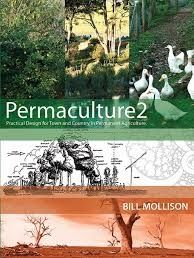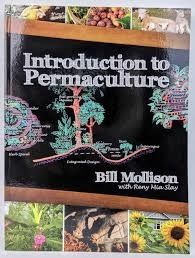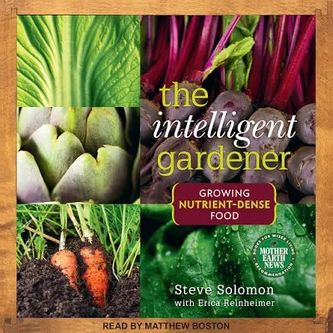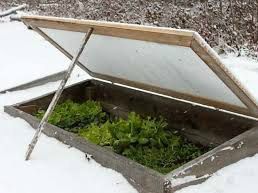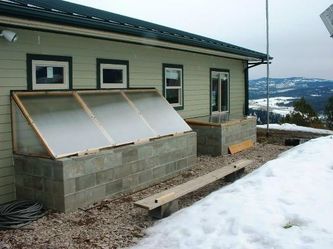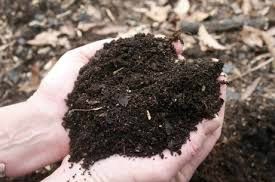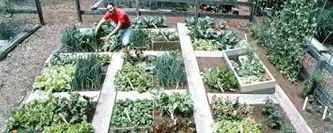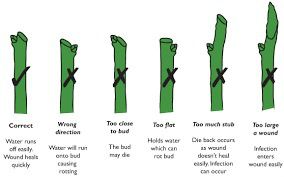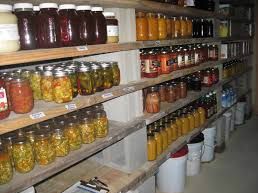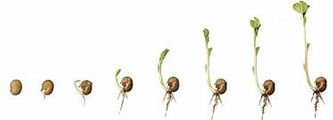PERMACULTURE 2
by Bill Mollison
After the 3 Days of Darkness, we may wake up to a burned out landscape and a changed weather system in our area. We may need to move to Brittany, France, or we may be able to plant seeds and start again where we are, with some strategies to combat climate changes (for example, strong winds without the protection of trees).
Whether in Brittany or elsewhere, we will have the best results if we employ the strategies used in Permaculture.
Bill Mollison is the father of Permaculture and runs the Permaculture Institute out of Tasmania, Australia. His website, www.tagari.com provides online classes and all the learning materials you will need to know how to begin again.
Chapter 1: Introduction
Chapter 2: Design in Landscape
Chapter 3: Soil Improvement
Chapter 4: Broad-scale Techniques
Chapter 5: Design for Difficult Climates
Chapter 6: Structures
Chapter 7: Waterworks
Chapter 8: Free-Range Poultry Design
Chapter 9: On Permaculture and Community
INTRODUCTION to PERMACULTURE by BILL MOLLISON
If you do not know what Permaculture is, go on Youtube and see some videos. Land layout, weather, water, and animals make for exciting inter-connectedness which can result in successful farming and raising of animals:
Chapter 1: Permaculture Principles (such as energy cycling, and small-scale intensive systems)
Chapter 2: Broad-scale Site Design
Chapter 3: Pattern Understanding
Chapter 4: Structures
Chapter 5: The Home Garden
Chapter 6: Orchards, Farm Forestry, and Grain Crops
Chapter 7: Animal Forage Systems and Aquaculture
Chapter 8: Urban and Community Strategies
Appendix A: List of Some Useful Permaculture Plants
Appendix B: Species Lists in Useful Categories
Appendix C: Common and Latin Plant Names
Appendix D: Glossary
THE INTELLIGENT GARDENER: GROWING NUTRIENT-DENSE FOOD
by Steve Solomon
If you like working with measurements, charts and worksheets, this book is for you!
Chapter 1: Why Nutrient-Dense Food?
Chapter 2: History From a Nutritional Viewpoint
Chapter 3: The Shit Method of Agriculture
Chapter 4: Complete Organic Fertilizer
Chapter 5: Remineralization
Chapter 6: Le Batterie de Cuisine
Chapter 7: The Soil Prescription
Chapter 8: Soils with Excesses
Chapter 9: Compost
Appendix C has the following worksheets: Acid Soil Worksheet, Excess Cations Worksheet, and Calcareous Soil Worksheet.
Four-Season Harvest
These cold frames are easy to build. You can use old windows on top and make the box out of bricks, wood, hay bales, anything that will hold the soil. Nails and hinges are optional!
by Eliot Coleman
Table of Contents
Chapter 1: Presenting the Four-Season Harvest
Chapter 2: Getting Started
Chapter 3: The Living Soil: Compost
Chapter 4: The Outdoor Garden: Planning and Preparing
Chapter 5: Seeds for Four Seasons
Chapter 6: The Outdoor Garden: Planting and Cultivating
Chapter 7: Garden Helpers
Chapter 8: Envisioning the Winter Garden
Chapter 9: The Covered Garden: Cold Frames
Chapter 10: The Covered Garden: Greenhouses and High Tunnels
Chapter 11: The Underground Garden: Root Crops, Roots Cellars, and Indoor Harvesting
Chapter 12: Protecting Plants: The Reactive Approach
Winter Gardening
The heat from the house will also help the plants in these two cold frames to keep from freezing. This type of winter harvest is continuous, and not difficult, since everything is just steps from the door.
by Binda Colebrook
Table of Contents
Chapter 1: The Principles of Winter Gardening
Chapter 2: Winter Gardening Mechanics
Chapter 3: Cloches, Frames and Polytunnels
Chapter 4: Sharecroppers
Chapter 5: Which Vegetables and Herbs to Grow
Gardening When It Counts
Your seeds for spring should also include flowers that feed pollinators such as bees and butterflies. Some summer vegetables cannot grow without the help of pollinators.
by Steve Solomon
Table of Contents
Chapter 1: Introduction: The Coming Hard Times, etc
Chapter 2: Basics
Chapter 3: Tools and Tasks
Chapter 4: Garden Centers
Chapter 5: Seeds
Chapter 6: Watering . . . and Not
Chapter 7: Compost
Chapter 8: Insects and Diseases
Chapter 9: What to grow . . . and How to Grow It
Chapter 10: Bibliography
The Sprout Garden
Once sprouted, these seeds and legumes have more nutrition to offer. Plus, if you are on the move, you can carry these in your backpack, sprout as you go, and you will not starve.
by Mark M. Braunstein
Table of Contents
Chapter 1: A Sproutariam Seminarium: Why to Sprout
Chapter 2: Sprout Ins & Outs: What to Sprout
Chapter 3: The Sprout Route: How to Sprout
Chapter 4: About Each Sprout
Chapter 5; Radicle Vegetarian Recipes
Dead Daisies Make Me Crazy
Composting is the way to make nutrient-rich soil to feed your fruits and veggies as they grow.
by Loren Nancarrow and Janet Hogan Taylor
Table of Contents
Chapter 1: Why Organic?
Chapter 2: Garden and Lawn Diseases and Remedies
Chapter 3: Pest Control Solutions for the Garden and Lawn
Chapter 4: Make-It-Yourself Fertilizers, Mulches, and Compost
Chapter 5: Planting, Potting, and Maintenance Solutions, and Some Tips on Tools
Chapter 6: Wildlife Loves an Organic Garden
Square Foot Gardening
These planks of wood are where you walk. You can also stand your sprinkler on these and irrigate from the middle outwards.
by Mel Bartholomew
Table of Contents
Chapter 1: Introduction
Chapter 2: What Is the Square Foot Method?
Chapter 3: Garden Sizes and Basic Layouts
Chapter 4: Tools for the Square Foot Garden
Chapter 5: Getting Started -- Sun, Soil, Drainage and Location
Chapter 6: Garden Planning: What and When to Plant
Chapter 7: Basic Spacing and Planting Methods
Chapter 8: Vertical Growing
Chapter 9: Structures to Build
Chapter 10: Starting Plants from Seed
Chapter 11: Transplanting
Chapter 12: Watering
Chapter 13: Controlling Weeds, Pests, and Diseases
Chapter 14: Enjoying the Harvest
Chapter 15: Extending the Growing Season
Chapter 16: End-of-Season Activities
Chapter 17: Special Gardens
Chapter 18: A Guide to Growing Crops by the Square Foot Method
The Pruning Book
Pruning is like getting a hair cut: it encourages new growth. Beware of buying or having gardening books that use the word "Bible" in their titles. The only Bible is our Holy Bible, our collection of the Holy Scriptures.
by Lee Reich
Table of Contents
Chapter 1: Why Prune?
Chapter 2: Tools of the Trade
Chapter 3: Plant Response to Pruning
Chapter 4: Deciduous Ornamental Bushes
Chapter 5: Deciduous Ornamental Trees
Chapter 6: Evergreen Trees and Bushes
Chapter 7: Ornamental Vines
Chapter 8: Edible Fruits and Nuts
Chapter 9: Houseplants
Chapter 10: Herbaceous Plants
Chapter 11: Pollarding
Chapter 12: Pleaching
Chapter 13: Topiary
Chapter 14: Standards
Chapter 15: Mowing
Chapter 16: Bonsai
Chapter 17: Espalier
Root Cellaring
An underground root cellar, with a house over top or 3 feet of dirt over its roof will also shield your family from nuclear radiation.
This is smart planning, and it is not hard to do.
Read Cresson Kearney's "Nuclear War Survival Skills" in our section called SURVIVAL BOOKS.
Also, remember that the prophecies of Marie-Julie mention very strong earthquakes, so secure shelves and items on shelves, especially glass!
Vermin (rats) can smell stored food, even when packaged, and they will chew through plastic storage containers, so you may want to try metal containers with tightly secured lids.
by Mike and Nancy Bubel
Table of Contents
Chapter 1: Planting Crops for Fall Storage
Chapter 2: Good Keepers
Chapter 3: Growers Keepers: How to Raise Top-Quality Storage Keepers
Chapter 4: How to Harvest and Prepare Vegetables for Storage
Chapter 5: Life After Picking
Chapter 6: Spoilage
Chapter 7: Food Value in Winter Keepers
Chapter 8: Vegetables
Chapter 9: Fruits
Chapter 10: The Underground Garden
Chapter 11: Other Good Food to Keep in Natural Cold Storage
Chapter 12: Trenches, Keeping-Closets, and Other Vegetable and Fruit Hideaways
Chapter 13: Planning Your Root Cellar
Chapter 14: Keeping Things Humming in the Root Cellar
Chapter 15: The Basement Root Cellar
Chapter 16: The Excavated Root Cellar
Chapter 17: Root Cellaring Experiences
Chapter 18: Cooking Sturdy Keepers
Seed Sowing and Saving
How to save seeds so that they remain able to germinate is a skill that requires a bit of learning and planning. Buy heritage, non-GMO seeds from online sources and read how to store them properly. Saving seeds is so important for after the 3 Days of Darkness.
by Carole B. Turner
Table of Contents
Chapter 1: Sowing Seeds
Chapter 2: From Seed to Bloom
Chapter 3: Selecting Plants for Seed Saving
Chapter 4: Collecting and Storing Seeds
Chapter 5: Annual Vegetables
Chapter 6: Biennial and Perennial Vegetables
Chapter 7: Annual Flowers
Chapter 8: Biennial and Perennial Flowers
Appendices: Optimal Germination Temperatures for Seeds, etc.
The Complete Guide to Saving Seeds
Here is the perfection of the seed. Warmth, moisture, nutrients and light is all a seed needs to grow.
by Robert Gough and Cheryl Moore-Gough
Table of Contents
Chapter 1: Seed Biology 101
Chapter 2: Growing Plants for Seeds
Chapter 3: Harvesting and Cleaning Seeds
Chapter 4: Seed Storage Know-How
Chapter 5: All About Germination
Chapter 6: Sowing Seeds and Raising Transplants
Chapter 7: Breeding Your Own Varieties
Chapter 8: Saving Vegetable Seeds
Chapter 9: Saving Herb Seeds
Chapter 10: Saving Flower Seeds
Chapter 11: Advanced Seed Saving: Nuts, Fruits, & Woody Ornamentals
